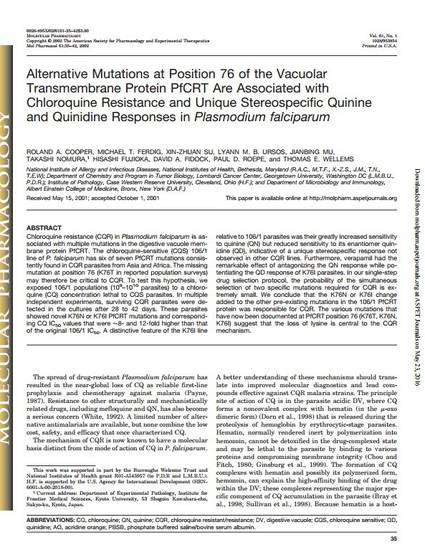
Article
Alternative Mutations at Position 76 of the Vacuolar Transmembrane Protein PfCRT Are Associated with Chloroquine Resistance and Unique Stereospecific Quinine and Quinidine Responses in Plasmodium falciparum
Molecular Pharmacology
(2002)
Abstract
Chloroquine resistance (CQR) in Plasmodium falciparum is associated with multiple mutations in the digestive vacuole membrane protein PfCRT. The chloroquine-sensitive (CQS) 106/1 line of P. falciparum has six of seven PfCRT mutations consistently found in CQR parasites from Asia and Africa. The missing mutation at position 76 (K76T in reported population surveys) may therefore be critical to CQR. To test this hypothesis, we exposed 106/1 populations (10(9)-10(10) parasites) to a chloroquine (CQ) concentration lethal to CQS parasites. In multiple independent experiments, surviving CQR parasites were detected in the cultures after 28 to 42 days. These parasites showed novel K76N or K76I PfCRT mutations and corresponding CQ IC(50) values that were approximately 8- and 12-fold higher than that of the original 106/1 IC(50). A distinctive feature of the K76I line relative to 106/1 parasites was their greatly increased sensitivity to quinine (QN) but reduced sensitivity to its enantiomer quinidine (QD), indicative of a unique stereospecific response not observed in other CQR lines. Furthermore, verapamil had the remarkable effect of antagonizing the QN response while potentiating the QD response of K76I parasites. In our single-step drug selection protocol, the probability of the simultaneous selection of two specific mutations required for CQR is extremely small. We conclude that the K76N or K76I change added to the other pre-existing mutations in the 106/1 PfCRT protein was responsible for CQR. The various mutations that have now been documented at PfCRT position 76 (K76T, K76N, K76I) suggest that the loss of lysine is central to the CQR mechanism.
Disciplines
Publication Date
2002
Citation Information
Roland A. Cooper, Michael T. Ferdig, Xin-zhuan Su, Lyann M. B. Ursos, et al.. "Alternative Mutations at Position 76 of the Vacuolar Transmembrane Protein PfCRT Are Associated with Chloroquine Resistance and Unique Stereospecific Quinine and Quinidine Responses in Plasmodium falciparum" Molecular Pharmacology Vol. 61 Iss. 1 (2002) p. 35 - 42 ISSN: 0026-895X Available at: http://works.bepress.com/roland_cooper/12/
